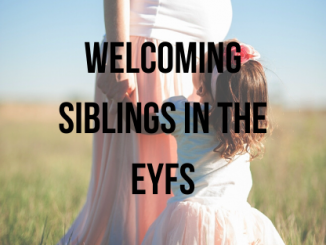The World Health Organisation and UNICEF recommend that children initiate breastfeeding within the first hour of birth and be exclusively breastfed for the first 6 months of life – meaning no other foods or liquids are provided, including water. They say “Infants should be breastfed on demand – that is as often as the child wants, day and night. No bottles, teats or pacifiers should be used” and recommend that solids are started only from the age of 6 months, when they should be considered “complementary foods” while continuing to breastfeed for up to 2 years and beyond.
As those working with families with young children, Early Years Teachers and practitioners are likely to encounter families feeding their infants in a range of different ways, and with a range of different support needs. This article is not intended to undermine any family’s infant feeding choices but instead takes a look at what real breastfeeding mums say they want their childcare providers to know about breastfeeding.
The Early Years sector is characterised by a plethora of different career journeys, pathways, education and qualifications and though, with recent updates to the qualification requirements, we are moving towards a more standardised qualification framework we are a long way off yet. With these different qualifications come different focuses and some may include information on infant feeding and more practical caring requirements but some do not, so for many of us, unless we have breastfed our own children, we simply may not know much about it.
I talked to breastfeeding mums who agreed to let me share their thoughts anonymously as part of this article, and here’s what they want us to know;
They want childcare providers to know why families choose to breastfeed. Many reported that they felt that childcare providers didn’t understand the importance of breastmilk and saw it as equal to, or even ‘less convenient’ than formula milk.
So, beginning to understand the science of human milk and breastfeeding is key to fully understanding why breastfeeding matters so much and to unambiguously supporting breastfeeding mothers. Human babies are designed to consume human milk (breastmilk) formula milk is made using the breastmilk of another animal and whilst we are lucky to have an alternative method of feeding a baby should we want or need to; it is not without risks. Globally around 823 000 infants die globally each year because they are not receiving the protective components found in human milk, many of these are in the developing world where lack of access to safe drinking water, adequate fuel, or a guaranteed supply of infant formula are hard to come by, but some are not.
Infant formula use increases the risks of respiratory illness, asthma, eczema, gastrointestinal infection, necrotizing enterocolitis, SIDS, diabetes and childhood cancer (especially leukemia) and for women, low breastfeeding rates are also associated with an increase in reproductive cancers (Breast cancer and ovarian cancer for example), heart disease, diabetes, weight gain, and postnatal depression. It’s estimated that improving breastfeeding rates could prevent 20,000 annual deaths from breast cancer.
Breastfeeding is an incredibly clever process when it comes to preventing illness and infection; It’s been theorized that as babies nurse, their saliva gives the mother’s body information about pathogens they have been exposed to, and from this information the mother produces antibodies to those pathogens which the baby receives in breastmilk. Topically, even before vaccines were widely available Covid 19 antibodies were found in the breastmilk of mothers who had been exposed to the illness, mums who were positive for Covid-19 and fed their babies found that the babies didn’t get sick or only had a mild dose of the illness. New data beginning to emerge is also showing that mothers who have been vaccinated against Covid 19 are passing their immunity to the disease to their babies through breastmilk.
As well as all these health benefits, breastfeeding can save a family plenty of money; A review by the UK government into Infant Feeding and Inequalities in 2018 found that if commonly available powdered formulations of cows’ milk based first infant formula are used the price can vary from £27.90 to £58.60 per month, meaning that using infant formula will cost, on average, £519 a year.
Another factor influencing families’ choice to breastfeed is environmental concern breastmilk benefits our environment as it requires no farming, processing, advertising, packaging or transportation. According to a 2019 study by The Imperial College, London, “Overall, breastfeeding for six months saves an estimated 95-153kg CO2 equivalent per baby compared with formula feeding.”
Perceptions of nursing older babies, toddlers, or young children was a subject that many mums raised, with one saying “I found it very difficult not to feel judged by our local nursery when it was mentioned we were still happily feeding at 3 years” Mums were keen that childcare providers understood that it is biologically normal for children to nurse well beyond the first few months. Indeed, as we have already mentioned the WHO recommends breastfeeding for at least 2 years. On a biological level, humans are designed feed to between 2.5 to 7 years, and when allowed to self-wean, most children stop breastfeeding between 3 and 4 years old, though some will nurse longer.
Mums worried not only about how childcare staff perceived breastfeeding older babies, toddlers, and young children but also how those perceptions would play out in the way that children were spoken to “It’s not helpful to tell my child they’re a big boy now and don’t need to breastfeed anymore” said one mother and some reported that staff had said things like “that’s for babies” to their nursing children.
Pace feeding got plenty of press too in my research, with lots of mums agreeing that childcare providers need to know how to pace feed.
Paced feeding is a technique that allows the baby to control the feeding session and eat at their own pace. It more closely mimics breastfeeding, making it easier for babies to switch back and forth between breast and bottle and ensuring that babies don’t overeat. Using this technique to feed a breastfed baby in a childcare setting helps to protect the breastfeeding relationship.
Other practical issues that mums mentioned were knowing the storage guidelines for expressed milk, expecting to feed on demand rather than a schedule, being able to identify feeding cues and understanding the variations in the appearance of expressed breastmilk. Whereas cow’s milk we buy in the shops and formula milk are homogenised and pasteurised, breastmilk is neither so it separates meaning that in a bottle you may see clearer more watery milk at the bottom, and a layer of yellowy fat on the top; this milk hasn’t gone off and it just needs a swirl to combine back together. Breastmilk also comes in a range of colours, sometimes looking white, yellow, blue-tinged or green-tinged. Some mothers report variation in the colour of their breastmilk when their children are fighting an illness.
Mums also suggested that they may need time and space to breastfeed before leaving and that a “breastfeeding friendly” sign and inclusive language on forms were important to them. “What formula does your child drink?” and “when did your baby stop breastfeeding?” being highlighted as examples of poor practice.
Childcare providers should, more than anyone, understand the importance of a child’s strong, secure attachment to their caregiver and breastfeeding promotes this. However, some mums felt that childcare providers saw breastfeeding and the close attachment relationship it demonstrates negatively; “Strong attachment is not an inconvenience or being too attached” said one. Another was keen to emphasise that breastfeeding “doesn’t magically make children clingy”
Breastfeeding is not a safeguarding issue, it’s a normal biological function and as childcare providers, it’s important that we understand this and understand how to respond to children talking about their nursing relationships. Since breasts are so sexualised in western culture, some practitioners may feel uncomfortable with some of the comments that children make; an example given was a toddler saying “I love mummy’s boobies” at nap time and heartbreakingly, some mums reported that staff had laughed at children’s comments or told them off. These aren’t appropriate responses “Children see breastfeeding as a normal thing to do” one mum explained, and childcare providers should support this viewpoint, offering affirmative comments like “that’s lovely” or “I bet mummy loves snuggling up to feed you”
It’s common to find bottles and dummies sold as accessories with dolls, whilst crocheted breasts haven’t really caught on! Whilst settings may or may not decide to introduce ‘wooly boobs’ to the role play area, thinking carefully about how feeding choices are portrayed is incredibly important. If your setting has bottles in the role play area, but no representation of breastfeeding what does that say to parents and children?
Whilst bottle feeding has become incredibly normalised and no one should be ‘shamed’ for their choices it’s important to understand that low breastfeeding rates are a significant public health issue. The UK has one of the worst breastfeeding rates in the world, partly due to lack of breastfeeding support, but also partly due to the deluge of formula marketing that took place before regulations were tightened (And goes on still with companies finding loopholes in the current laws) If childcare providers are to claim that they are ‘health-promoting’ then it is worth considering what they are doing to normalise breastfeeding, and whether tins of formula are ever an appropriate resource.
This quote encompasses the idea that it is not our place to give advice or opinions unless we are specifically asked. Several mums relayed that they had received unwanted advice about weaning their child, even though they weren’t trying to! Perhaps this relates back to society’s lack of understanding about normal nursing patterns but childcare providers should temper their language and consider how language might be received when talking to parents “is he still breastfeeding?” can come across as very judgmental and critical.
Likewise, when speaking to parents who are feeding infant formula, questions and comments about why the baby isn’t breastfed can be hurtful; over 80% of mums start breastfeeding but by 6 weeks this has drastically decreased due to lack of support, and almost all of these mums said that they had to stop breastfeeding before they were ready.
And saying well done is a good idea! Breastfeeding is hard work, misunderstood and underappreciated.
This is a great way to finish up; ultimately breastfeeding mums didn’t expect childcare providers to know everything about breastfeeding but found it frustrating when they pretended that they knew more than they did and would just prefer to be asked.













